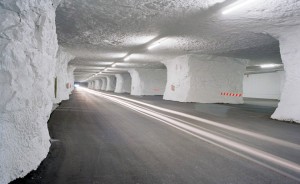 After recently seeing a picture of a truck down in one of the “cave warehouses” near Kansas City, Missouri, it made me remember the times I had been down in those caves with my truck, so I started doing a little “digging” and found that there are several of these unique underground warehouses across the country. Underground warehouses can be found in the states of Missouri, Pennsylvania, New York, Kentucky, Indiana and Illinois, just to name a few. Most of these underground facilities occupy previous mining sites, which is a great second use for what some might consider “useless” or “used up” space.
After recently seeing a picture of a truck down in one of the “cave warehouses” near Kansas City, Missouri, it made me remember the times I had been down in those caves with my truck, so I started doing a little “digging” and found that there are several of these unique underground warehouses across the country. Underground warehouses can be found in the states of Missouri, Pennsylvania, New York, Kentucky, Indiana and Illinois, just to name a few. Most of these underground facilities occupy previous mining sites, which is a great second use for what some might consider “useless” or “used up” space.
Many of you may not even be aware that these underground facilities even exist, but I can assure you they do, because I have been inside many of them. I have delivered to or picked up at the one outside of Carthage, MO and a couple different warehouses in the Kansas City area. I knew about these caves before, but in my research I unearthed a lot more than I ever knew about them. It’s a pretty interesting journey, but you won’t need a miner’s hat or light for this trip!
It is a different feeling the first time you drive into one of these man-made caves, but they are usually painted white and well-lit. Still, it’s kind of scary and kind of cool at the same time. But you have to be very careful not to get too close to a wall or pillar because you can tear your trailer up pretty easy down there. I remember one cave that I went to where the yard dog had to pull the trailer in because our truck was too big for the facility.
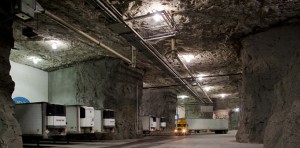 Limestone mining began in the late 1800’s with little regard for the shape of the space that their excavation left behind. But by the 1950’s, people started realizing that this space could be used after the miners were gone. Using the “room and pillar” method of hard rock mining, usable underground space could be left behind. The miners began by tunneling into the bluffs and hills, removing huge squares of stone in grid patterns up to 150 feet below the surface. Today, the result is millions of square feet of usable space, dominated by huge natural pillars holding up the ceilings. The pillars’ even spacing, concrete flooring and 16-foot high, smooth ceilings make build-to-suit facilities time and cost efficient for tenants.
Limestone mining began in the late 1800’s with little regard for the shape of the space that their excavation left behind. But by the 1950’s, people started realizing that this space could be used after the miners were gone. Using the “room and pillar” method of hard rock mining, usable underground space could be left behind. The miners began by tunneling into the bluffs and hills, removing huge squares of stone in grid patterns up to 150 feet below the surface. Today, the result is millions of square feet of usable space, dominated by huge natural pillars holding up the ceilings. The pillars’ even spacing, concrete flooring and 16-foot high, smooth ceilings make build-to-suit facilities time and cost efficient for tenants.
One of the first underground storage facilities was in Livingston, New York. In 1936, Herman Knaust paid $9,000 for a depleted iron ore mine in Livingston so he could have more room to grow his mushrooms on the 100 acres above it. His Hudson River Valley neighbors called him the “Mushroom King” because he had made his fortune growing mushrooms. But by 1950, the mushroom market shifted and Mr. Knaust needed to find an alternative use for his old mine (which he called Iron Mountain). In 1951, at the start of the Cold War, with fears of atomic bombs ever-present, he formed Iron Mountain Atomic Storage, Inc., which provided high-security underground storage vaults in his mine.
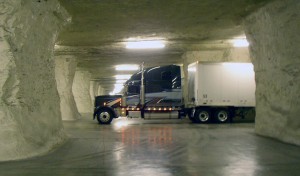 With a sales office in the Empire State Building, Iron Mountain offered safe storage of vital information from wars and disasters. General Douglas MacArthur visited the site and the publicity from this visit was the extent of the company’s marketing program – but that was all it needed. East River Savings Bank was their first account, bringing microfilm copies of deposit records and duplicate signature cards in armored cars for storage in the mountain facility. Other large corporate customers soon followed as they realized the need to protect their vital records. Today, Iron Mountain is the leader in safe storage. Mr. Knaust displayed great foresight in 1952 when he said (about Iron Mountain Atomic Storage), “This business will mushroom!” The company’s revenue in 2010 was 3.1 billion dollars.
With a sales office in the Empire State Building, Iron Mountain offered safe storage of vital information from wars and disasters. General Douglas MacArthur visited the site and the publicity from this visit was the extent of the company’s marketing program – but that was all it needed. East River Savings Bank was their first account, bringing microfilm copies of deposit records and duplicate signature cards in armored cars for storage in the mountain facility. Other large corporate customers soon followed as they realized the need to protect their vital records. Today, Iron Mountain is the leader in safe storage. Mr. Knaust displayed great foresight in 1952 when he said (about Iron Mountain Atomic Storage), “This business will mushroom!” The company’s revenue in 2010 was 3.1 billion dollars.
One of the most secure Iron Mountain facilities is located two hundred feet under Boyers, Pennsylvania. 2,700 employees work in the 130-acre underground vault which has its own restaurant, fire truck, water treatment plant and backup power infrastructure. The limestone mine was originally opened in 1902 by U.S. Steel, who abandoned the site in 1952. At that point, National Underground Storage bought 80 acres of the mine and convinced the federal government to store some of its vital documents there. Iron Mountain bought the site from National Underground Storage in 1998. Today, the United States Office of Personnel Management and the United States Patent and Trademark Office both maintain some of their most highly-sensitive documents there. The Corbis Corporation, a company owned by software billionaire Bill Gates that licenses the rights to more than 100 million images and 500,000 video clips, also stores their entire collection of originals at the Boyers, PA underground site.
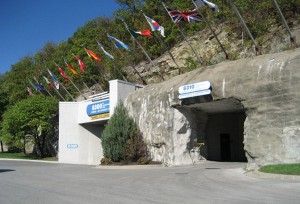 Carved out of an enormous limestone deposit underneath Kansas City is the world’s largest business park. Established in 1964, Hunt Midwest SubTropolis spans 1,100 acres and offers 55,000,000 total square feet of space – and it is all underground! Fifty local, national and international businesses are located there, employing some 1,500 workers. The entrances to the SubTropolis complex seem to rise out of nowhere, and when big trucks enter the man-made cave, it looks as if they are disappearing right into the hillside. Currently 5,000,000 square feet is occupied and 10,000,000 square feet are improved. About 3.2 acres of available space are added each year as active mining continues.
Carved out of an enormous limestone deposit underneath Kansas City is the world’s largest business park. Established in 1964, Hunt Midwest SubTropolis spans 1,100 acres and offers 55,000,000 total square feet of space – and it is all underground! Fifty local, national and international businesses are located there, employing some 1,500 workers. The entrances to the SubTropolis complex seem to rise out of nowhere, and when big trucks enter the man-made cave, it looks as if they are disappearing right into the hillside. Currently 5,000,000 square feet is occupied and 10,000,000 square feet are improved. About 3.2 acres of available space are added each year as active mining continues.
On the ground above SubTropolis, people enjoy the “Worlds of Fun” amusement park, while 100 feet below them is a bustling enterprise system. Stored at SubTropolis is everything from sacks of coffee beans to original reels of Gone With The Wind. The U.S. Postal Service also stores hundreds of millions of commemorative stamps at SubTropolis. There are over two miles of railroad corridors, almost seven miles of roads, and 10,000 huge limestone pillars down there, all laid out in a grid 40 feet apart. To keep things organized, the gigantic white pillars are numbered to serve as postal addresses.
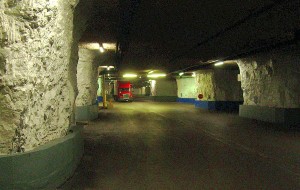 Everyone is “going green” these days, and these caves are the perfect location for efficiency-minded companies. The weather in the caves is always predictable – overcast and in the mid-60’s. Vanguard Packaging, a cardboard display manufacturer, has 360,000 square feet of space at SubTropolis that they don’t need to heat or cool. CEO Mark Mathes, an outspoken advocate for environmental sustainability, also hopes to install a wind turbine on the surface that would generate as much electricity as the company uses. Vanguard’s goal is for their facility to become completely carbon neutral. SubTropolis covers over 10% of the industrial space available in the greater Kansas City area, and with millions of square feet of additional space still available for future tenants, SubTropolis will continue to lead the way in “down under” facilities.
Everyone is “going green” these days, and these caves are the perfect location for efficiency-minded companies. The weather in the caves is always predictable – overcast and in the mid-60’s. Vanguard Packaging, a cardboard display manufacturer, has 360,000 square feet of space at SubTropolis that they don’t need to heat or cool. CEO Mark Mathes, an outspoken advocate for environmental sustainability, also hopes to install a wind turbine on the surface that would generate as much electricity as the company uses. Vanguard’s goal is for their facility to become completely carbon neutral. SubTropolis covers over 10% of the industrial space available in the greater Kansas City area, and with millions of square feet of additional space still available for future tenants, SubTropolis will continue to lead the way in “down under” facilities.
Carthage Underground is a collection of marble quarries in Carthage, Missouri, most of which are presently owned by Americold Logistics. They currently hold 43,000,000 square feet of the quarry, much of which is occupied by warehouses or factories, primarily for food production. The total area of Carthage Underground is difficult to trace, but it has been rumored to stretch out as far as Joplin, Missouri (about 20 miles from Carthage).
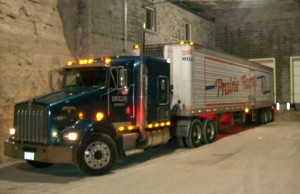 In 1991, a fire broke out in one of Americold’s underground storage facilities in Kansas City, but despite continuous firefighting efforts (there were no sprinklers) it took almost two months for the fire to burn itself out. The fire, which started in an area of the cave containing grocery items like cleaning compounds, pesticides, paper goods and cooking oil, reached temperatures as high as 2,000 degrees. The fire was confined to one section of the cave, but the smoke flowed throughout the facility, ruining 245 million pounds of food. Today, sprinkler systems come standard in all new businesses. If a fire was to break out now, local fire officials would be able to respond within minutes because the technology in place automatically monitors the premises and can alert the authorities.
In 1991, a fire broke out in one of Americold’s underground storage facilities in Kansas City, but despite continuous firefighting efforts (there were no sprinklers) it took almost two months for the fire to burn itself out. The fire, which started in an area of the cave containing grocery items like cleaning compounds, pesticides, paper goods and cooking oil, reached temperatures as high as 2,000 degrees. The fire was confined to one section of the cave, but the smoke flowed throughout the facility, ruining 245 million pounds of food. Today, sprinkler systems come standard in all new businesses. If a fire was to break out now, local fire officials would be able to respond within minutes because the technology in place automatically monitors the premises and can alert the authorities.
The Louisville Mega Cavern started out as the Louisville Crushed Stone Quarry, where miners removed a mind-boggling amount of limestone for over 42 years. It was acquired in 1989 by private investors who wanted to develop a portion of the man-made cavern into a high-security storage facility. Located just a few miles from the Kentucky Expo Center and Louisville International Airport, this huge 100-acre facility is capable of shrugging off a 260-mph tornado and boasts a constant temperature of 56 degrees. And in the post 9-11 world, companies looking for ultimate security can take comfort in the fact that this facility claims it could withstand a hit from a 747 jet airliner and sustain no damage. Construction to carve out offices and storage spaces is ongoing – they have only made a dent in the more than 4,000,000 square feet of space. And even though it’s underground, the Louisville Mega Cavern is still the largest building in the entire state of Kentucky.
Even with these numerous advantages, underground warehouses still have some issues to deal with when making these caves safe and desirable for the thousands of people who go into them every day. Ventilation is a primary concern, but most of the mines have good air flow because they usually have more than one entrance. Structural integrity is always a concern, but limestone is three times stronger than concrete. Developers of these caves use various methods to ensure that the rock ceilings aren’t shifting. Engineers use sensitive instruments, equipped with warning flags, to detect any movement in the earth (down to a thousandth of an inch). If any separation develops in the stone, even from the natural movement of the earth, a flag will drop. They also use bore holes to look for laminations or loose layers in the roof.
These underground facilities have so much to offer in regards to climate control, safety and security. Some claim that these man-made caves will soon be the banks of tomorrow – a place where we will one day store our valuables, instead of in a safety deposit box at our local bank branch. As we run out of usable space above the ground, these subterranean business complexes will continue to dig their way into the future.

3 Comments
This is a pretty neat article. Found it after doing some research after delivering to the KC facility recently.
These caves are not what you think. Those are not pillars. They are artesian wells that are hidden under the roads and businesses above. The are hollowed out to vibrate as trucks and cars pass over.
The vibration electrifies the water in the aquifer along with minerals and it travels to a collection point where its broken down into some kind of steam turbine.
Now you know!
Are there puplic tours of these facilities?